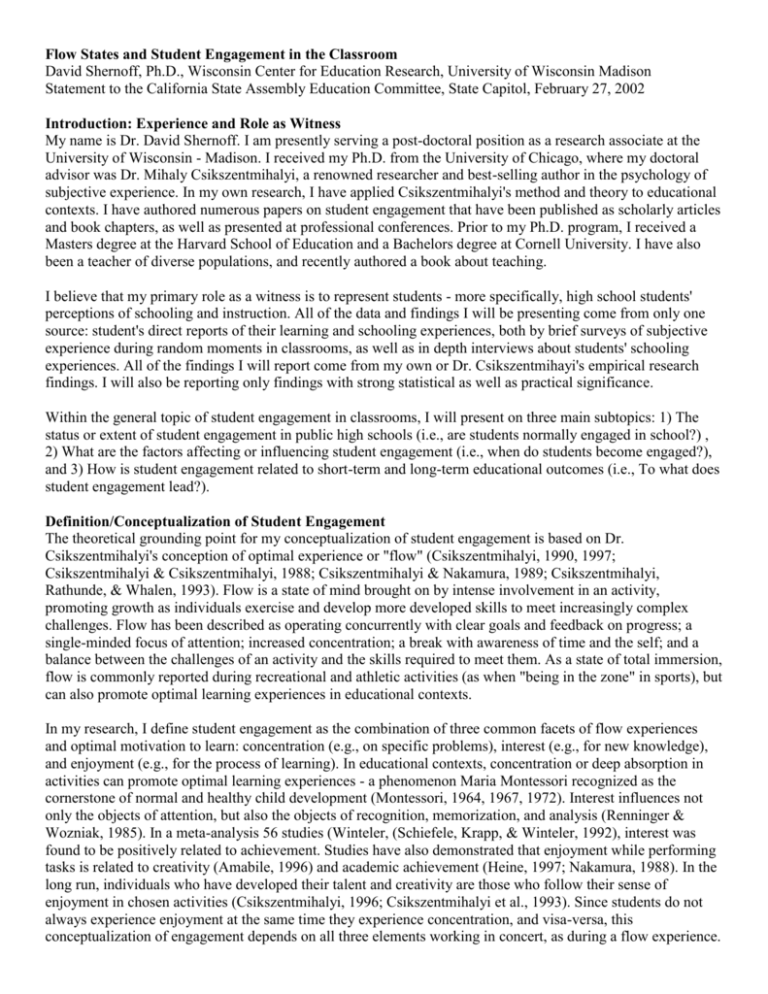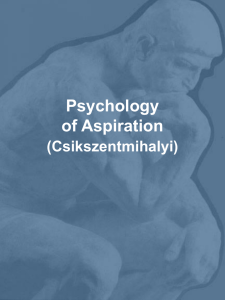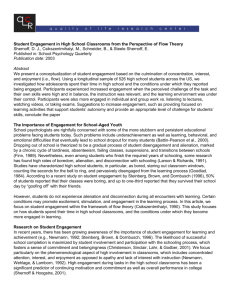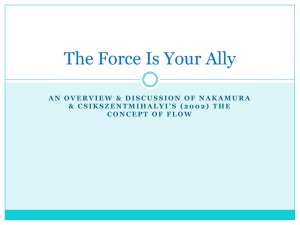Flow States and Student Engagement in the Classroom
advertisement

Flow States and Student Engagement in the Classroom David Shernoff, Ph.D., Wisconsin Center for Education Research, University of Wisconsin Madison Statement to the California State Assembly Education Committee, State Capitol, February 27, 2002 Introduction: Experience and Role as Witness My name is Dr. David Shernoff. I am presently serving a post-doctoral position as a research associate at the University of Wisconsin - Madison. I received my Ph.D. from the University of Chicago, where my doctoral advisor was Dr. Mihaly Csikszentmihalyi, a renowned researcher and best-selling author in the psychology of subjective experience. In my own research, I have applied Csikszentmihalyi's method and theory to educational contexts. I have authored numerous papers on student engagement that have been published as scholarly articles and book chapters, as well as presented at professional conferences. Prior to my Ph.D. program, I received a Masters degree at the Harvard School of Education and a Bachelors degree at Cornell University. I have also been a teacher of diverse populations, and recently authored a book about teaching. I believe that my primary role as a witness is to represent students - more specifically, high school students' perceptions of schooling and instruction. All of the data and findings I will be presenting come from only one source: student's direct reports of their learning and schooling experiences, both by brief surveys of subjective experience during random moments in classrooms, as well as in depth interviews about students' schooling experiences. All of the findings I will report come from my own or Dr. Csikszentmihayi's empirical research findings. I will also be reporting only findings with strong statistical as well as practical significance. Within the general topic of student engagement in classrooms, I will present on three main subtopics: 1) The status or extent of student engagement in public high schools (i.e., are students normally engaged in school?) , 2) What are the factors affecting or influencing student engagement (i.e., when do students become engaged?), and 3) How is student engagement related to short-term and long-term educational outcomes (i.e., To what does student engagement lead?). Definition/Conceptualization of Student Engagement The theoretical grounding point for my conceptualization of student engagement is based on Dr. Csikszentmihalyi's conception of optimal experience or "flow" (Csikszentmihalyi, 1990, 1997; Csikszentmihalyi & Csikszentmihalyi, 1988; Csikszentmihalyi & Nakamura, 1989; Csikszentmihalyi, Rathunde, & Whalen, 1993). Flow is a state of mind brought on by intense involvement in an activity, promoting growth as individuals exercise and develop more developed skills to meet increasingly complex challenges. Flow has been described as operating concurrently with clear goals and feedback on progress; a single-minded focus of attention; increased concentration; a break with awareness of time and the self; and a balance between the challenges of an activity and the skills required to meet them. As a state of total immersion, flow is commonly reported during recreational and athletic activities (as when "being in the zone" in sports), but can also promote optimal learning experiences in educational contexts. In my research, I define student engagement as the combination of three common facets of flow experiences and optimal motivation to learn: concentration (e.g., on specific problems), interest (e.g., for new knowledge), and enjoyment (e.g., for the process of learning). In educational contexts, concentration or deep absorption in activities can promote optimal learning experiences - a phenomenon Maria Montessori recognized as the cornerstone of normal and healthy child development (Montessori, 1964, 1967, 1972). Interest influences not only the objects of attention, but also the objects of recognition, memorization, and analysis (Renninger & Wozniak, 1985). In a meta-analysis 56 studies (Winteler, (Schiefele, Krapp, & Winteler, 1992), interest was found to be positively related to achievement. Studies have also demonstrated that enjoyment while performing tasks is related to creativity (Amabile, 1996) and academic achievement (Heine, 1997; Nakamura, 1988). In the long run, individuals who have developed their talent and creativity are those who follow their sense of enjoyment in chosen activities (Csikszentmihalyi, 1996; Csikszentmihalyi et al., 1993). Since students do not always experience enjoyment at the same time they experience concentration, and visa-versa, this conceptualization of engagement depends on all three elements working in concert, as during a flow experience. Method and Data Source How do we know if students are concentrating, interested, or enjoying their activities? In our research, we simply asked students to rate their own subjective states during instructional activities. Most of the data presented here was collected using a method developed by Dr. Csikszentmihalyi called the Experience Sampling Method or ESM. To carry out the ESM, pre-programmed wristwatches signal the sampled students randomly eight times throughout a day over the course of a normal week. Students are then asked to fill out a one-page self-report form (ESF) each time they were signaled. The ESM self-report form (ESF) asks students where they are and what they are doing at the exact moment of the beep, and also contains several items measured pertaining to one's subjective experience on a Likert scale from 0 (low) to 9 (high) (e.g., "How well were you concentrating?). The ESF may be found in Appendix A, and a fuller list of the variables frequently used in this study and how they were measured is provided in Table 1. In addition to the ESM data, I also analyzed in-depth, semi-structured interviews students provided about schooling and how it relates to their future goals. In a series of studies on student engagement (Shernoff, 2001a; Shernoff, 2001b, Shernoff & Csikszentmihalyi, 2000; Shernoff, Csikszentmihalyi, & Shernoff, in press; Shernoff & Hoogstra, 2001; Shernoff, Knauth, & Makris, 2000), colleagues and I analyzed both ESM and interview data from The Sloan Study of Youth and Social Development (SSYSD), a nationally representative, longitudinal study which investigated how students think about their lives in relationship to the future (Csikszentmihalyi & Schneider, 2000). The study collected data in three waves: 1992-1993 (Year 1), 1994-1995 (Year 3), and 1996-1997 (Year 5). Twelve research sites across the U.S. were selected for the study. Sites were widely distributed geographically and differed in the level of urbanization, racial and ethnic composition, labor force composition, and economic stability. The studies on student engagement selectively utilized a subsample of the SSYSD consisting of 526 tenth and twelfth grade students from three separate cohorts in the 1990s. The sample was approximately 62% female and 38% male; 16% African American, 8% Asian, 10% Hispanic, and 64% Caucasian; 7% low income; 15% working class; 37% middle class; 27% upper-middle class; and 14% upper class (The breakdown of race/ethnicity does not total to 100% due to missing data). A response bias occurred under-representing males, Hispanics and low-income students compared to national demographics. I have analyzed approximately 3,630 ESM responses given in a classroom context for the purpose of studying student engagement. Further details concerning the sampling design and procedures of the full-scale study can be found in Csikszentmihalyi & Schneider (2000). Findings: Are Public High School Students Engaged? The stereotype of students in American high schools is that of being bored, staring out classroom windows, and counting the seconds for the bell to ring. Is this stereotype true? Our research provides evidence that high school students are indeed more bored and less engaged while in public classrooms than they are otherwise. By using individually normed scores, each student's ESM scores can be viewed in relation to his or her own average. In other words, a score of 0 is each student's own average throughout an entire week. Any score above a 0 is above that student's own average for the week reflected in standard deviations, and any score below 0 is below that student's own average. For example, a score of -1 on the variable concentration means that the student's concentration in classrooms was one standard deviation below his or her own average for the week while in classrooms. Examining the average scores for our entire sample can tell us how American students felt in classrooms compared to when they are not in them. These averages can be viewed in Table 2. Student's average score on engagement is negative, indicating that students are less engaged in classrooms than elsewhere. In fact, students' enjoyment while in class is over one quarter of a standard deviation below their average in other contexts, suggesting students experience little enjoyment while in classrooms. Students also indicate being less interested in what they are doing while in class. Student's overall mood and self-esteem also appear to be negative while in classrooms. Interestingly, students do appear to concentrate harder while in class than elsewhere, suggesting that concentration may not be related to students' perception of their affect. While approximately one third of the overall variation in student engagement is among different students, nearly two thirds of that variation is among learning environments, as the same students move from one activity to another over the course of a typical week. Findings: When Do Students Become Engaged in Classrooms? Students pay more attention and concentrate harder when they are challenged. As shown in Figure 1, students concentrate harder, are more interested, and are more engaged overall when they are challenged. In fact, students' engagement is below average in low challenge situations, but above average in high challenge situations. These findings suggest that many students may be bored because they find class work too easy, and that more cognitively complex and challenging class work engages students more deeply. However, high challenge is also associated with lower enjoyment and self-esteem. Even though challenging tasks may increase students' focus, they may also provoke unpleasant worry about the negative consequences of unsuccessful completion, as with test anxiety. Such negative emotions arise most likely when the task is too difficult. Students experience greater enjoyment, motivation, self-esteem, and overall engagement when they can actively demonstrate their skills and perceive them to be high. As illustrated in Figure 2, students report greater selfesteem, motivation, enjoyment and overall engagement when they perceive their skills to be high rather than low. The same is true when students consider themselves to be active and in control, as with activities in which they freely demonstrate their skills. This suggests that the perception of competence and how it relates to perceived chances of success contributes to student's motivation and sense of self-worth. Students are optimally engaged when the level of challenge is a good match for students' skills such that perceived challenges and skills are both high and in balance. Dr. Csikszentmihalyi's empirically supported theory of flow holds that the experience in any activity may be optimized when a person feels that both challenges and skills are higher than usual and are relatively in balance ((Carli, Fave, & Massimini, 1988; Csikszentmihalyi et al., 1993; Massimini & Massimo, 1988). In addition, various ratios of challenges and skills are predicted to lead to different qualities of experience (Csikszentmihalyi & Nakamura, 1989), as illustrated in Figure 3. When challenges and skills are both low, one is likely to feel apathetic. When challenges are high and skills are low, anxiety may be experienced. When challenges are low and skills are high, then one is likely to experience relaxation. When challenges and skills are both high, one is more likely to experience flow. True to the theory, Figure 4 and Figure 5 illustrate that student engagement, concentration, and attention in classrooms is optimized by an appropriate balance between challenge and skills. "Appropriate" may be taken to mean, "offering the prospect of success with reasonable effort" (Brophy, 1983). Optimally engaging activities are neither trivially simple nor impossibly hard. The right match between challenge and skills should lead to optimum motivation, and is related to the quality of pupil's learning experiences. Students are more engaged, particularly in terms of concentration and interest, when instruction is perceived as relevant and meaningful to their lives. As illustrated in Figure 6, high school students' interest, concentration and overall engagement is above average and significantly higher when students indicate that instruction is important to themselves and their future goals. When instruction is found to be less relevant, students are less engaged than average. Such findings suggest that students are more likely to become engaged with authentic academic work that intellectually involves them in a process of meaningful inquiry to solve problems with relevance in the world beyond the classroom. Overall, students' attention and concentration is most influenced by two factors: the challenge and relevance of instruction. Students are more engaged in group and individual work than while listening to a lecture, watching TV or a video, or while taking a test or quiz. As illustrated in Figure 7, students reported higher engagement during group work and individual work than while watching television or video, listening to their teacher lecture, or while taking a test or quiz. As can be seen in Figure 8, students report higher concentration, enjoyment, and motivation when involved in individual or group work as compared to listening to a lecture or watching TV or video. While taking a test, students concentrate harder than most other common classroom activities, but they enjoy it less than most other activities. Overall, students appear more engaged during instructional methods that present opportunities for action and to demonstrate their skills. They appear to be less engaged when passive recipients of a general body of information transmitted to the entire class, or in activities that are controlled exclusively by the teacher. Taking tests or quizzed appears to be a special case in which students report extremely high levels of concentration and importance, but extremely low levels of enjoyment and motivation. Students are significantly more engaged in their non-academic courses than their academic ones. By asking students where they are at the time they are beeped, the ESM allows a comparison of student engagement across academic and non-academic subjects. A ranking of school subjects by student engagement is presented in Table 3. Students report being the most engaged in art, computer science and vocational education, the three nonacademic subjects examined. They report lower engagement in social studies/science, English, science, foreign language, history, and math. While students find their academic courses more challenging, they report higher enjoyment, interest, and motivation in their non-academic classes. This finding may be partially explained by the differences between subjects with respect to allocation of time using various instructional formats, as presented in Table 4. For example, students spend much more time engaged in individual work in their nonacademic classes, and much more time listening to lecture in their traditional, academic ones. Overall, students spend more time in activities in which they report being more engaged during their non-academic classes, and more time in activities in which they report being less engaged during their academic ones (see Table 5). Thus, non-academic classes such as art appear to emphasize the momentary rewards of direct interaction, while academic classes may be perceived as serious, formal, and directive, but often dull and devoid of pleasure. Overall, studies on student engagement suggest that traditional academic subjects would benefit by rethinking their pedagogical strategies in order to allow students a better balance between challenges and skills, as well as higher levels of activity and control. Findings: The Relationship Between Student Engagement and Academic Outcome. There is a significant relationship between attention and short-term performance, but only a small and insignificant relationship between student engagement and short-term performance. The later is explained in terms of the undermining effects of evaluation on students motivational orientation. I have analyzed the relationship between student engagement and short-term performance as measured by students' self-reported grades, both within various school subjects as well as overall. While there is a significant relationship between attention and short-term performance in math, science, and English, the relationship between student engagement and self-reported grades is small, insignificant, and in some cases, slightly negative. In other words, attention and concentration are related to short-term performance, while enjoyment, interest, and motivation are only weakly or negatively related. While there may be multiple interpretations to the second part of this finding, the leading ones that are most well established by the research literature point to the effects of tests, grades, and evaluation on goal and motivational orientations. Intrinsic motivation and engagement are facilitated by a task-involving orientation, but impeded by a performance or ego orientation (Maehr & Nicholls, 1980; Nicholls, 1984). Therefore, strong concerns or an overemphasis on performance may also undermine engagement with instruction, especially interest and enjoyment experienced in the moment. A recent meta-analysis of 128 studies concluded that performance-contingent rewards undermined self-reported interest and task enjoyment (Deci, Koestner, & Ryan, 1999). More specifically, external evaluation and emphasis on social comparisons appears to have negative consequences on students' interest (Boggiano, Main, & Katz, 1988; Deci & Ryan, 1985), their pursuit of challenging tasks (Elliott & Dweck, 1988), and their use of learning strategies (Ames, 1984). The pervasiveness of evaluation makes it difficult to focus on learning (Covington and Beery, (Covington & Beery, 1976). Students quickly adopt the mind-set that what is not evaluated is not worth learning, even topics arousing natural curiosity before evaluation or rewards "overjustified" engagement in learning (an effect known as "the overjustification hypothesis," Lepper and Greene, 1978). The qualitative analyses I have performed on students' in-depth interviews of their schooling and motivation supports the above explanation. Three patterns emerged when comparing students exhibiting high engagement in classrooms as measured by the ESM method to those exhibiting low engagement: i) Use of free time: Highly engaged students commented more frequently on their involvements with athletics, work, specific activities with friends, and home responsibilities compared to disengaged students, who spoke more frequently about "hanging out" with their friends. (ii) Clear Goals: highly engaged students were more likely to develop clear goals for the future related to their interests, in contrast to disengaged students, who were more frequently uncertain about their future goals. (iii) Intrinsic vs. extrinsic motivation: Highly engaged students were more likely to discuss school performance in terms of enjoyment of learning activities and reaching their future goals; in contrast, disengaged students appeared more oriented towards receiving good grades as an end in itself. For example, compare the statements of an engaged student to that of a non-engaged student: "(Why do you want to be an astronaut?) Cause I've always been interested in like the space program and stuff….Yeah, I've always like, I mean like always reading books and I've always been interested in like the space program and…(Mm hm.) …I mean I'm sure it goes in with like science again…" (Student A, High Engagement) "Well, I was thinking, uh, I was thinking of competitively about, I should write better than some people. Like English…I want to be better than the other person (inaudible) for me to be as best I can… That doesn't really sound very well, nice, but…I, it just seems like I can. I have to be…best at everything… And I, I'm like the most ambitious person you'll ever know. (Um hum.)…Seriously, I think I'll, I'll turn in eventually into one of those greedy people. (Um hum.) Because it seems like when, when people have rule and like very much power, they just…turn into some kind of big monster…I just want to be so rich. It's just…sickening" (Student B, Low Engagement) I would like to note that while Student A is poised to be a more engaged learner in the long run due to his intrinsic interest in science, student B is actually more likely to study harder for a better grade in the short term. Hence, there is a weak and sometimes even negative relationship between grades and engagement. There is a positive and significant relationship between student engagement and continuing motivation in the domain of science, as well as between student engagement and long-term performance. In a follow-up study to the Sloan study funded by the National Institute on Postsecondary Education, Libraries, and Lifelong Learning, I tested whether students reporting high engagement in math and science classes in high school were more likely to continue their interest in those subjects two years later once in college, after accounting for student background characteristics including present performance. The measure for continuing motivation was the choice to major in a science-related field in college among students reporting high engagement in high school science class, and the choice of a math-related major among students exhibiting high engagement in high school math class. Engagement was a significant predictor of continuing motivation in science. Concentration, enjoyment, and interest in high school science class all predicted the choice of a science related major in college (see Table 6). I also tested whether student engagement among that same sample of math and science student was related to performance in college two years later as measured by self-reported grades, again accounting for a variety of student background characteristics including present grades. Not only was student engagement a significant predictor of long-term performance in college, particularly in terms of interest and enjoyment (see Table 7), but it was a stronger predictor than the other variables in the statistical model including present grades. In other words, how much interest and enjoyment students reported at random moments in high school math and science classes was a stronger predictor of college grades than high school grades. Unlike short-term performance, attention in high school classes was not as strongly related to either long-term continuing interest or performance. These findings suggest that engagement with school learning can have an important influence on educational outcomes. However, those outcomes are not necessarily the ones receiving the most attention. While the field of education has been preoccupied with short-term achievement and grades, this research suggests that engagement may operate in subtle ways that has important, long-term effects on students' intellectual and professional development. It appears that enjoyment, interest and other aspects of engagement may provide the foundation for subsequent learning and career development. Conclusion Research on student engagement suggests that students are less engaged than usual while in public high school classrooms, particularly in their academic classes. Classes and activities that have the greatest probability of engaging students both in the short-term and the long term are sufficiently "complex" in that they both demand attentive concentration as well as invite immediate enjoyment and interest. The hopeful result of such an educational approach is psychological complexity, whereby students are motivated by the immediate enjoyment of learning as well building the skills necessary to reach their future goals. There appears to be two separate processes related to student engagement.. The experience of challenge and relevance have strong effects particularly on students' concentration, interest, and attention. I refer to this process as "academic intensity." Experiencing high skill, control, and activity level are associated with significant increases in mood, enjoyment, esteem, and intrinsic motivation. I refer to this process as "positive emotional response," which is distinguished from the primarily cognitive nature of academic intensity. Both academic intensity and a positive emotional response appear to be an integral part of optimal engagement in classrooms. It is apparent, however, from the studies I have conducted as well as other studies (e.g., Csikszentmihalyi et al., 1993), that both processes frequently do not operate together during public high school instruction. For example, students find taking a test or a quiz, or many activities in math class, to be very challenging and demanding of concentration, but they frequently do not enjoy the experience. Students enjoy watching television or video, or attending art class, but they often feel these experiences lack challenge and relevance. It appears that some activities can combine both aspects of engagement, such as individual work in computer science class or a group lab activity in science class; whereas others appear to be lacking in both aspects, such as listening to the teacher lecture or the experience of history class compared to many others. A model of these processes and how they relate to educational outcomes is presented in Figure 7. Academic intensity appears to be more related to short-term performance than positive emotions. For example, attention appears to have a stronger relationship with short-term performance than many of the more emotionally based factors On the other hand, the emotional side of engagement, particularly students' enjoyment and interest, appears to be a strong predictor of long-term performance and motivation. The observation of these processes imply that activities which are both academically intense and foster positive emotions are more likely to engage students both in the short term and in the long term. Ideally, the schools and teachers of the future will develop activities that are more complex in that they are challenging and relevant, and yet also allow students to feel confident in their ability and in control; exact concentration but also provide enjoyment; are intrinsically satisfying in the short-term, as well as build a foundation of skills and interest for the future; and involve both intellect and feeling; and that are both work-like and play-like - which is to say, activities that engage. Table 2 Z-Scores of Experiential Variables in High School Classrooms ESM Variables Mean SD Minimum Maximum N Engagement -.0686 .7481 -2.92 2.05 3418 Interest -.0407 .9501 -3.11 2.77 3462 Concentration .1700 .9812 -4.36 3.57 3545 Enjoyment -.2851 .9745 -4.91 2.71 3515 Table 4 Percentage of Time Devoted to Instructional Methods by School Subject Lecture TV/Videos Test/Quiz Individual work Groupwork School Subject Total a N=382 N=129 N=226 N=411 n=104 Mathematics 23.7% 1.5% 21.1% 24.1% 4.4% 74.8% English 22.7% 6.3% 9.9% 26.8% 4.1% 69.8% Science 19.4% 4.0% 15.4% 15.1% 12.7% 66.6% Foreign 22.3% 9.1% 13.7% 26.3% 4.6% 76.0% Language History 31.2% 8.7% 10.9% 13.8% 5.8% 70.4% Social 22.7% 10.6% 10.1% 17.9% 2.4% 63.7% Studies/Sci. Computer 6.1% 3.0% 6.1% 60.6% 0.0% 75.8% Science Art 17.3% 8.0% 2.7% 44.0% 5.3% 77.3% Vocational Ed. 20.0% 15.2% 12.4% 35.2% 4.8% 87.6% Combined 21.9% 7.4% 13.1% 23.6% 5.9% 71.9% a Percentages do not total to 100% due to missing data and alternative instructional methods not reported here. (Only five of the most common instructional methods are reported here.) ?2 /F-test = 155.31, p < .001 Table 5 The Percentage of Time Spent in High Engagement Instructional Methods by School Subject Foreign Science Language N=625 N=358 (6) (3) 55.3% (5) 54.3% 52.3% Math English N=582 N=710 History N=225 (7) 51.9% (9) 40.6% Social Studies Computer Science Art N=384 N=97 N=302 (8) 44.9% (1) 69.7% (2) 60.0% Vocational Ed. X2/ N=248 F Statistic (4) 55.2% 19.88*** Note: Sample sizes reflect the number of ESM responses, not individuals, in each activity. Numbers denote a ranking of scores. * p < .05 ** p < .01 *** p < .001 a High engagement instructional methods refers to Individual and Group work as distinguished from test/quiz, Lecture, and TV/Video. This distinction was based on previous analyses. Table 6 Controlled Logistic Regression Coefficients Predicting Choice of Science Major in College With Student Engagement and its Components Variable Engagement Interest Concentration Enjoyment Attention Coefficient .698** .631** .362 8.78** .265 Note: Coefficient predicting selection of a college major in science from motivational variables in science classes measured two years prior, during the senior year of high school, after controlling for gender, race, socioeconomic status, family type, and previous performance. N=53. * p < .10 ** p < .05 *** p < .01 Table 7 Controlled Multiple Regression Coefficients College Grades with Components of Student Engagement in High School Classrooms Variable Engagement Interest Concentration Enjoyment Attention Coefficient .181* .178* .056 .164** -.449 Note: Coefficient predicting grades in college from motivational variables in math and science classes measured two years prior, during the senior year of high school, after controlling for gender, race, socioeconomic status, family type, and previous performance. N=75. ·*p < .10 ** p < .05 *** p < .01 References Amabile, T. (1996). Creativity in context: Update to "The social psychology of creativity.". Boulder, CO: Westview Press. Ames, C. (1984). Achievement attributions and self-instructions under competitive and individualistic goal structures. Journal of Educational Psychology, 76(3), 478-487. Boggiano, A. K., Main, D. S., & Katz, P. A. (1988). Children's preference for challenge: The role of perceived competence and control. Journal of Personality & Social Psychology, 54(1), 134-141. Brophy, J. E. (1983). Conceptualizing student motivation. Educational Psychologist, 18(3), 200-215. Carli, M., Fave, A. D., & Massimini, F. (1988). The quality of experience in the flow channels: Comparison of Italian and U.S. students. In M. Csikszentmihalyi & I. S. Csikszentmihalyi (Eds.), Optimal experience: Psychological studies of flow in consciousness (pp. 288-318). New York, NY, USA: Cambridge University Press. Covington, M. V., & Beery, R. G. (1976). Self-worth and school learning. New York: Holt, Rinehart & Winston. Csikszentmihalyi, M. (1990). Flow : The psychology of optimal experience. New York: HarperPerennial. Csikszentmihalyi, M. (1996). Creativity: Flow and the psychology of discovery and invention. New York: HarperCollins. Csikszentmihalyi, M. (1997). Finding flow: The psychology of engagement with everyday life. The masterminds series. New York: Basic Books. Csikszentmihalyi, M., & Csikszentmihalyi, I. S. (Eds.). (1988). Optimal experience: Psychological studies of flow in consciousness. New York: Cambridge University Press. Csikszentmihalyi, M., & Nakamura, J. (1989). The dynamics of intrinsic motivation: A study of adolescents. In R. Ames & C. Ames (Eds.), Research on motivation in education (Vol. 3). San Diego, CA: Academic Press. Csikszentmihalyi, M., Rathunde, K., & Whalen, S. (1993). Talented teenagers: The roots of success and failure. New York: Cambridge University Press. Csikszentmihalyi, M., & Schneider, B. (2000). Becoming adult: How teenagers prepare for the world of work. New York: Basic Books. Deci, E. L., & Ryan, R. M. (1985). Intrinsic motivation and self-determination in human behavior. New York: Plenum. Elliott, E. S., & Dweck, C. S. (1988). Goals: An approach to motivation and achievement. Journal of Personality & Social Psychology, 54(1), 5-12. Heine, C. A. (1997). Task enjoyment and mathematical achievement., University of Chicago, Chicago. Maehr, M. L., & Nicholls, J. G. (1980). Culture and achievement motivation: A second look. In N. Warren (Ed.), Studies in cross cultural psychology. San Diego, CA: Academic Press. Massimini, F., & Massimo, C. (1988). The systematic assessment of flow in daily experience. In M. Csikszentmihalyi & I. S. Csikszentmihalyi (Eds.), Optimal experience: Psychological studies of flow in consciousness (pp. 266-287). New York: Cambridge University Press. Montessori, M. (1964). The Montessori method. New York: Schocken Books. Montessori, M. (1967). The absorbent mind ( [1st ] ed.). New York: Holt Rinehart and Winston. Montessori, M. (1972). The secret of childhood. New York: Ballantine Books. Nakamura, J. (1988). Optimal experience and the uses of talent. In M. Csikszentmihalyi & I. S. Csikszentmihalyi (Eds.), Optimal experience: Psychological studies of flow in consciousness (pp. 319-326). New York: Cambridge University Press. Nicholls, J. G. (1984). Achievement motivation: Conceptions of ability, subjective experience, task choice, and performance. Psychological Review, 91(3), 328-346. Renninger, K. A., & Wozniak, R. H. (1985). Effect of interest on attentional shift, recognition, and recall in young children. Developmental Psychology, 21(4), 624-632. Schiefele, U., Krapp, A., & Winteler, A. (1992). Interest as a predictor of academic achievement: a metaanalysis of research. In K. A. Renninger & S. Hidi & A. Krapp (Eds.), The role of interest in learning and development (pp. 183-212). Hillsdale, N. J.: Erlbaum. Shernoff, D. (2001). Assessing multiple influences on student engagement in high school classrooms. Paper presented at the Annual Meeting of the American Educational Research Association, Seattle, Washington. Shernoff, D., & Csikszentmihalyi, M. (2000). The affective and emotional development of adolescents from working families. Paper presented at the Work and Family: Expanding the Horizons, San Francisco. Shernoff, D., Knauth, S., & Makris, E. (2000). The quality of classroom experiences. In M. Csikszentmihalyi & B. Schneider (Eds.), Becoming adult: How teenagers prepare for the world of work. New York: Basic Books. http://www.amersports.org/library/reports/8.html









